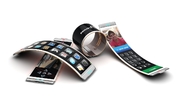Future Smartphone Patents Point to Innovation

The future of smartphones is seeming pretty spectacular these days, with an endless number of patents covering unique features like flexible OLEDs, iris recognition software and even self-healing displays. Here’s a quick look at what’s in the pipeline:
Samsung has been working on developing devices with flexible displays now for years and is finally expected to have its first foldable phone ready for launch sometime this year. Right now, all patents seem to be pointing at the release of the Galaxy X, rumored to feature flexible OLED technology, dual screens and more. One patent even hints at the use of a hinge-system (similar to that of a traditional flip-phone), which would allow users to fold the phone up for compact storage and then unfold it for a 180-degree full-screen display.
Microsoft is working on developing a smartphone that could one day replace the need for a laptop, tablet or other computer. The Surface Phone, rumored to be ready for release later this year, is allegedly designed to support Win32 apps, giving users the ability to operate multiple Windows programs right on their phones. A recent patent also hints at the possibility of a dual display, where one side of the device is a regular screen and the other electronic paper. Future versions of the device may even include the iris recognition software, Iris ID, rather than a passcode lock or fingerprint scanner, as another recent patent indicates.
Meanwhile, Apple seems to be focusing on making its devices more durable. A recent patent for a shock-absorbing system could save iPhone users hundreds of dollars in screen repair fees. The patent describes a system of sensors, capable of detecting when a device is in free fall, that would trigger four corner cushions or “bumpers” to deploy and help prevent damage to the phone. However, scientists at the University of California, Riverside may have discovered a better solution to the problem of cracked phone screens. A self-healing smartphone may be possible in the near future, thanks to a new screen material discovered by Chao Wang and his team. The unique material is composed of a stretchable polymer and an ionic salt that have the ability to stretch up to fifty times their original size and that work together to self-repair any nicks or cracks within 24-hours.
What features would you choose for your next smartphone? Share with us, here.
